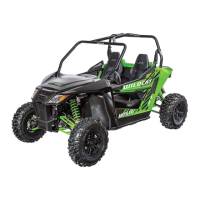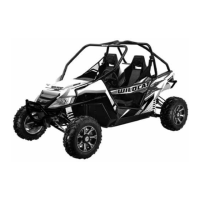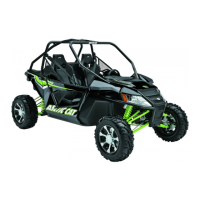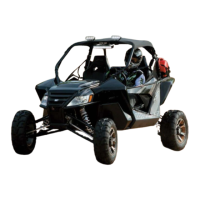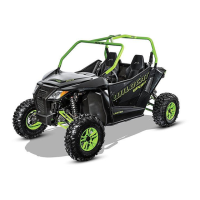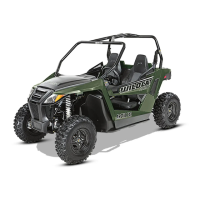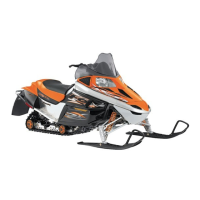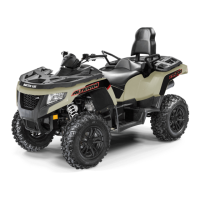Do you have a question about the Arctic Cat Wildcat TRAIL/XT and is the answer not in the manual?
Responsible operation and respect for environment and laws.
Information on genuine parts, catalogs, and recommended service manuals.
Crucial warnings about the vehicle's hazardous nature and safe operation.
Explains the meaning and importance of various safety warning decals on the vehicle.
Identifies and illustrates various vehicle components and their functions.
Comprehensive safety warnings covering operation, hazards, and user responsibilities.
Technical data, dimensions, capacities, and fluid types for the vehicle.
General guidelines for operating the vehicle and a pre-operation checklist.
Step-by-step procedure for starting the engine and warming it up.
Explains how to select transmission ranges (P, R, N, H, L) and their uses.
Basic principles for driving the vehicle after it has warmed up.
Details on how to brake and stop the vehicle smoothly and safely in various conditions.
Procedure for parking the vehicle safely, including on inclines.
Guidance on turning techniques, considering steering effort and surface conditions.
Safe practices for climbing hills, including speed, gear selection, and avoiding turns.
Safe practices for descending hills, emphasizing engine braking and speed control.
How to safely navigate obstacles, including inspection and approach.
Guidelines for operating in reverse, focusing on visibility and slow speed.
How to handle loss of control due to skidding or sliding on slippery surfaces.
Operating the vehicle in water, with safety precautions regarding depth and current.
Guidelines for safely crossing roads or highways, considering traffic and visibility.
Precautions and procedures for operating in cold weather conditions, including tire and brake checks.
Foundational information about the vehicle's identification and controls.
Location and importance of VIN and ESN for service and registration.
Description of keys and their use for starting and accessory power.
Explains dashboard layout, switches, and levers for operating the vehicle.
Describes the ignition switch positions (OFF, RUN, START) and their functions.
Operation of the transmission shift lever for selecting gears.
Controls 2WD, 4WD, and differential lock engagement for traction.
Information on the primary service brake and its application for stopping.
How to adjust the steering wheel position for operator comfort.
Controls high and low beams for proper illumination.
System for overriding the reverse speed limiter for increased RPM.
How to control engine speed and vehicle movement by pressing the pedal.
Procedure for securing and releasing the vehicle seats.
Proper use and fastening of seat belts for operator and passenger safety.
Procedure for securing and releasing the vehicle doors to ensure containment.
Information on the Electronic Power Steering system and its function.
Description of the instrument cluster display, buttons, and indicators for vehicle status.
List of codes displayed on the LCD and their meanings for troubleshooting.
Describes the function and operation of the electric fuel pump.
Maintenance recommendation for gas hoses, including replacement interval.
Procedure for checking the engine oil level.
Guidelines for safely towing trailers, including speed, handling, and weight limits.
Vehicle weight limits for operator, passenger, cargo, and towing capacities.
Procedure for securing the vehicle for transport using hold-down straps.
Recommended fuels, oils, and lubricants for the vehicle's operation and maintenance.
Type of gasoline to use, including octane rating and acceptable additives.
Type of oil for engine and transmission, including viscosity and specifications.
Engine oil viscosity chart and recommendations for severe operating conditions.
Recommended lubricants for differentials and transaxle for proper function.
Initial break-in procedures for the engine and components to ensure longevity.
Procedure to break in brake pads for optimal braking effectiveness.
Break-in for suspension components and CV joints for proper flex.
Break-in procedure for the drive belt to ensure flexibility and extend its life.
Importance of proper maintenance for optimal performance and vehicle longevity.
Schedule of inspections, cleaning, and replacements based on mileage or time intervals.
Information on the cooling system, coolant mixture, and maintenance checks.
Location and maintenance of the oil cooler for optimal engine oil cooling.
Inspection and adjustment of shock absorbers for ride quality and performance.
Procedure to check and adjust vehicle ride height for proper suspension setup.
Lubrication advice for various components to ensure smooth operation.
Lubrication advice for cables to ensure smooth operation.
Detailed procedure for changing engine oil and filter.
Procedure for inspecting and changing differential and transaxle lubricant.
Information on the hydraulic brake system and its components.
Checking and adding brake fluid to the reservoir.
Inspection of hydraulic brake hoses for cracks or damage.
Procedure for checking brake pad thickness and replacement.
Inspection of protective boots on suspension and steering components.
Inspection of drive axle boots for tears or damage.
Maintenance, cleaning, and charging of the vehicle battery for optimal performance.
Procedure for charging the battery using a maintainer or charger.
Steps for charging the vehicle battery using approved chargers.
Procedure for jump-starting the vehicle safely in an emergency.
Information on spark plug inspection, gap adjustment, and replacement.
Procedure for cleaning the air inlet pre-filter to ensure clean air intake.
Procedure for cleaning and inspecting the air filter and housing.
Procedure for draining water from the V-belt cover after driving through water.
Information on tire specifications, condition, replacement, and repair.
Minimum tread depth requirements for safe tire operation.
Proper procedures and tools for tire replacement to ensure safety.
Guidance on repairing tubeless tires using plug kits.
Procedure for removing and installing wheels, including lug nut torque specifications.
Cleaning the muffler and spark arrester to maintain performance and compliance.
Procedure for replacing headlight bulbs.
Procedure for replacing taillights and brakelights.
How to adjust headlight aim for proper road illumination and visibility.
Location and replacement of fuses in the power distribution module for electrical troubleshooting.
Description of accessory power terminals for adding electrical devices.
Location of the glove box and the provided tool kit for basic repairs.
Inspection of seat belts for wear and proper retraction and latching.
Inspection of vehicle doors for damage and latch security.
Inspection of the Rollover Protection Structure for damage or modification.
Procedure to prepare the vehicle for storage to prevent rust and component deterioration.
Procedure for taking the vehicle out of storage and preparing it for riding.
Terms and conditions of the limited warranty, including coverage periods and limitations.
Parts and conditions not covered by the warranty, such as normal wear or abuse.
Steps for warranty claims and owner's duties regarding maintenance and service.
Emission control warranty details and owner responsibilities for US models.
Log for recording all maintenance services performed on the vehicle, including date and mileage.
Form for updating owner information or transferring warranty to a new owner.
Section to record key, VIN, and ESN for reference and parts ordering.
Responsible operation and respect for environment and laws.
Information on genuine parts, catalogs, and recommended service manuals.
Crucial warnings about the vehicle's hazardous nature and safe operation.
Explains the meaning and importance of various safety warning decals on the vehicle.
Identifies and illustrates various vehicle components and their functions.
Comprehensive safety warnings covering operation, hazards, and user responsibilities.
Technical data, dimensions, capacities, and fluid types for the vehicle.
General guidelines for operating the vehicle and a pre-operation checklist.
Step-by-step procedure for starting the engine and warming it up.
Explains how to select transmission ranges (P, R, N, H, L) and their uses.
Basic principles for driving the vehicle after it has warmed up.
Details on how to brake and stop the vehicle smoothly and safely in various conditions.
Procedure for parking the vehicle safely, including on inclines.
Guidance on turning techniques, considering steering effort and surface conditions.
Safe practices for climbing hills, including speed, gear selection, and avoiding turns.
Safe practices for descending hills, emphasizing engine braking and speed control.
How to safely navigate obstacles, including inspection and approach.
Guidelines for operating in reverse, focusing on visibility and slow speed.
How to handle loss of control due to skidding or sliding on slippery surfaces.
Operating the vehicle in water, with safety precautions regarding depth and current.
Guidelines for safely crossing roads or highways, considering traffic and visibility.
Precautions and procedures for operating in cold weather conditions, including tire and brake checks.
Foundational information about the vehicle's identification and controls.
Location and importance of VIN and ESN for service and registration.
Description of keys and their use for starting and accessory power.
Explains dashboard layout, switches, and levers for operating the vehicle.
Describes the ignition switch positions (OFF, RUN, START) and their functions.
Operation of the transmission shift lever for selecting gears.
Controls 2WD, 4WD, and differential lock engagement for traction.
Information on the primary service brake and its application for stopping.
How to adjust the steering wheel position for operator comfort.
Controls high and low beams for proper illumination.
System for overriding the reverse speed limiter for increased RPM.
How to control engine speed and vehicle movement by pressing the pedal.
Procedure for securing and releasing the vehicle seats.
Proper use and fastening of seat belts for operator and passenger safety.
Procedure for securing and releasing the vehicle doors to ensure containment.
Information on the Electronic Power Steering system and its function.
Description of the instrument cluster display, buttons, and indicators for vehicle status.
List of codes displayed on the LCD and their meanings for troubleshooting.
Describes the function and operation of the electric fuel pump.
Maintenance recommendation for gas hoses, including replacement interval.
Procedure for checking the engine oil level.
Guidelines for safely towing trailers, including speed, handling, and weight limits.
Vehicle weight limits for operator, passenger, cargo, and towing capacities.
Procedure for securing the vehicle for transport using hold-down straps.
Recommended fuels, oils, and lubricants for the vehicle's operation and maintenance.
Type of gasoline to use, including octane rating and acceptable additives.
Type of oil for engine and transmission, including viscosity and specifications.
Engine oil viscosity chart and recommendations for severe operating conditions.
Recommended lubricants for differentials and transaxle for proper function.
Initial break-in procedures for the engine and components to ensure longevity.
Procedure to break in brake pads for optimal braking effectiveness.
Break-in for suspension components and CV joints for proper flex.
Break-in procedure for the drive belt to ensure flexibility and extend its life.
Importance of proper maintenance for optimal performance and vehicle longevity.
Schedule of inspections, cleaning, and replacements based on mileage or time intervals.
Information on the cooling system, coolant mixture, and maintenance checks.
Location and maintenance of the oil cooler for optimal engine oil cooling.
Inspection and adjustment of shock absorbers for ride quality and performance.
Procedure to check and adjust vehicle ride height for proper suspension setup.
Lubrication advice for various components to ensure smooth operation.
Lubrication advice for cables to ensure smooth operation.
Detailed procedure for changing engine oil and filter.
Procedure for inspecting and changing differential and transaxle lubricant.
Information on the hydraulic brake system and its components.
Checking and adding brake fluid to the reservoir.
Inspection of hydraulic brake hoses for cracks or damage.
Procedure for checking brake pad thickness and replacement.
Inspection of protective boots on suspension and steering components.
Inspection of drive axle boots for tears or damage.
Maintenance, cleaning, and charging of the vehicle battery for optimal performance.
Procedure for charging the battery using a maintainer or charger.
Steps for charging the vehicle battery using approved chargers.
Procedure for jump-starting the vehicle safely in an emergency.
Information on spark plug inspection, gap adjustment, and replacement.
Procedure for cleaning the air inlet pre-filter to ensure clean air intake.
Procedure for cleaning and inspecting the air filter and housing.
Procedure for draining water from the V-belt cover after driving through water.
Information on tire specifications, condition, replacement, and repair.
Minimum tread depth requirements for safe tire operation.
Proper procedures and tools for tire replacement to ensure safety.
Guidance on repairing tubeless tires using plug kits.
Procedure for removing and installing wheels, including lug nut torque specifications.
Cleaning the muffler and spark arrester to maintain performance and compliance.
Procedure for replacing headlight bulbs.
Procedure for replacing taillights and brakelights.
How to adjust headlight aim for proper road illumination and visibility.
Location and replacement of fuses in the power distribution module for electrical troubleshooting.
Description of accessory power terminals for adding electrical devices.
Location of the glove box and the provided tool kit for basic repairs.
Inspection of seat belts for wear and proper retraction and latching.
Inspection of vehicle doors for damage and latch security.
Inspection of the Rollover Protection Structure for damage or modification.
Procedure to prepare the vehicle for storage to prevent rust and component deterioration.
Procedure for taking the vehicle out of storage and preparing it for riding.
Terms and conditions of the limited warranty, including coverage periods and limitations.
Parts and conditions not covered by the warranty, such as normal wear or abuse.
Steps for warranty claims and owner's duties regarding maintenance and service.
Emission control warranty details and owner responsibilities for US models.
Log for recording all maintenance services performed on the vehicle, including date and mileage.
Form for updating owner information or transferring warranty to a new owner.
Section to record key, VIN, and ESN for reference and parts ordering.
| Brand | Arctic Cat |
|---|---|
| Model | Wildcat TRAIL/XT |
| Category | Offroad Vehicle |
| Language | English |
